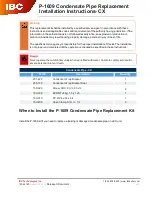
LAARS Heating Systems
Page 42
7.2.8 Ignitor / Flame Sensor Assembly
The ignitor is a 110v “Hot Surface” type. It
is energized whenever there is a call for heat and
switched off when ignition is established and the flame
has been sensed. To replace the ignitor, shut off the
120-volt power to the appliance, disconnect the Molex
connector, remove the two mounting screws on the
ignitor flange, and pull the ignitor out. Always install a
new ignitor gasket with the replacement ignitor.
Caution
Ignitor gets hot.
7.2.9 Transformers
There are three transformers in the Rheos
unit. One is 24v to 110v, the second is 110v to 24v,
and the third is 110v to 220v. Be sure to replace the
transformers with factory parts. These transformers are
not capable of supplying control voltage for external
devices such as zone valves, which must have their
own separate power supply. Should a transformer need
replacing, shut off the 120-volt power. Unplug the
transformer wires, remove the mounting screws and
remove the transformer. Replace transformer in the
reverse order.
7.2.10 Blower
The combustion air blower is a high-pressure
centrifugal blower with a variable speed motor. The
speed of the motor is determined by the control logic.
If a blower change is required, turn off the 120-volt
power and gas supply to the unit. Take the front panel,
the two side access panels, and the top jacket panel
off. (If there is enough clearance on the side, the top
may not have to be removed.) Disconnect the gas
union between the blower and gas valves. Disconnect
the filter box assembly (at the air transition) from the
blower (six 8 mm bolts). Disconnect the two Molex
electrical connectors from the top right of the blower.
Remove the four nuts from the blower flange, and
pull the blower out. Replace blower in reverse order,
ensuring that all joints are made correctly and sealed.
After replacement, ensure that the unit operates
properly, by following the set-up procedure in this
manual.
7.2.11 Flow Switch
The Rheos uses a paddle-type flow switch to
ensure that the unit has water flow before ignition is
allowed.
7.2.12 Heat Exchanger Coil
Black carbon soot buildup on the external
surfaces of the heat exchanger is caused by one
or more of the following; incomplete combustion,
combustion air problems, venting problems and heater
short cycling. Soot buildup or other debris on the heat
exchanger may restrict the flue passages.
If black carbon soot buildup is suspected,
disconnect electrical supply to the unit, and turn off
the gas supply by closing the manual gas valve on the
unit. Access the heat exchanger through the side access
panels, and inspect the finned copper tubing using a
flashlight. If there is a buildup of black carbon soot
or other debris on the heat exchanger, clean per the
following:
Caution
Black carbon soot buildup on a dirty heat exchanger
can be ignited by a random spark or flame. To
prevent this from happening, dampen the soot
deposits with a wet brush or fine water spray before
servicing the heat exchanger.
1. Disconnect the electrical supply to the unit.
2. Turn off the gas supply by closing the manual gas
valve on the heater.
3. Disconnect and remove the wires, conduit and
sensors from all components that are attached to
the inlet/outlet header.
4. Isolate the heat exchanger from the water supply.
5. Drain the heat exchanger from the drain located
on the bottom of the heat exchanger.
6. Disconnect the header flanges from the inlet and
outlet.
7. Remove the heat exchanger from the unit.
NOTE: The heat exchangers are heavy and may
require two people to remove to avoid personal
injury.
8. Clean the heat exchanger: A light accumulation
of soot or corrosion on the outside of the heat
exchanger can be easily removed. Use a wire
brush to remove loose soot and scale from the
heat exchanger. Do not use water or compressed
air for cleaning.
9. NOTE: While the heat exchanger is out of the
unit, inspect the firewall refractory insulation
blocks for cracks, wear and breakage. Replace if
necessary.
10. Inspect the inside of the copper tubes for scale
buildup. Scale can build up on the inner surface
of the heat exchanger tubes, which can restrict
water flow. If the tubes show signs of scaling,
clean the internal surface. Laars offers a tube
cleaning kit part number R2000700.
11. Reassemble in the reverse order.
If heat exchanger removal is necessary, consult
the factory for instructions.
NOTE: The Warranty does not cover damage
caused by lack of required maintenance, lack of
water flow, or improper operating practices.
Summary of Contents for Rheos RHCH
Page 28: ...LAARS Heating Systems Page 28 Figure 20 Wiring Diagram Model 1200 Codes B and E...
Page 32: ...LAARS Heating Systems Page 32 Figure 24 Wiring Diagram Model 1200 Pump Mounted Codes B and E...
Page 53: ...Rheos Boiler and Water Heater Page 53 Figure 42 Electrical Components...
Page 57: ...Rheos Boiler and Water Heater Page 57...
Page 58: ...LAARS Heating Systems Page 58...
















































